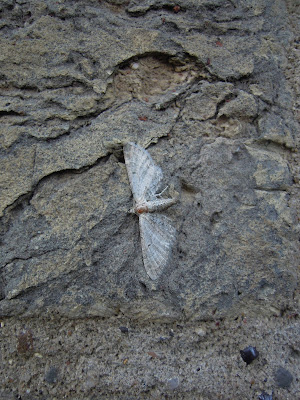I was lucky enough to receive a rather tasty MV trap for my birthday and this was the first opportunity of getting it out. First impressions were definitely favourable with the number and range of moths seeming pretty good considering that it wasn't optimal weather conditions.
Eight were new for the garden, with of two of these being 'Cottenham lifers' - so a good night:
[364] Beautiful Plume
[365] Aethes smeathmanniana
[366] Acleris laterana
[367] Rhyaconia pinicolana
[368] Agriphila straminella
[369] Plain Pug
[370] Barred Rivulet
[371]Square-spotted Clay
This all means that I have now recorded over 100 new species in this second year of trapping compared to last year. The first completely new species was Barred Rivulet and in fact there were at least two individuals (another probable got away) - this is a species of chalk soils so perhaps its no surprise that I haven't seen it before.
A. smeathmanniana was the other totally new one and the third species of Aethes recorded this year:
After the above two, Square-spotted Clay was the undoubted highlight. A very smart moth which is nationally scarce and only the second time I've picked one up in Cottenham:
Rhyaconia pinocolana is a smart tortrix and recorded very infrequently here my me (just two records in 2013):
Acleris laterana and comariana are a difficult species pair normally requiring dissection. Although I may report this eventually as the aggregate species, the time of capture and size of the moth points firmly to the former species:
Plain Pug is never a stunner but this one is even worse than normal:
Even less interesting than pugs perhaps are grass moths - I am surely guilty of totally overlooking A. straminella as its an abundant species. However, I looked at the small crambids this time around and they were all this species rather than C. culmella.
Just to get some colour in the post, here's a few good looking species:
Eight were new for the garden, with of two of these being 'Cottenham lifers' - so a good night:
[364] Beautiful Plume
[365] Aethes smeathmanniana
[366] Acleris laterana
[367] Rhyaconia pinicolana
[368] Agriphila straminella
[369] Plain Pug
[370] Barred Rivulet
[371]Square-spotted Clay
This all means that I have now recorded over 100 new species in this second year of trapping compared to last year. The first completely new species was Barred Rivulet and in fact there were at least two individuals (another probable got away) - this is a species of chalk soils so perhaps its no surprise that I haven't seen it before.
 |
| Barred Rivulet Perizoma bifaciata |
 |
| Barred Rivulet Perizoma bifaciata - second individual |
 |
| Aethes smeathmanniana |
After the above two, Square-spotted Clay was the undoubted highlight. A very smart moth which is nationally scarce and only the second time I've picked one up in Cottenham:
 |
| Square-spotted Clay Xestia stigmatica |
Rhyaconia pinocolana is a smart tortrix and recorded very infrequently here my me (just two records in 2013):
 |
| Rhyaconia pinicolana |
Acleris laterana and comariana are a difficult species pair normally requiring dissection. Although I may report this eventually as the aggregate species, the time of capture and size of the moth points firmly to the former species:
 |
| Acleris laterana |
Plain Pug is never a stunner but this one is even worse than normal:
 |
| Plain Pug Eupithecia simpliciata |
Even less interesting than pugs perhaps are grass moths - I am surely guilty of totally overlooking A. straminella as its an abundant species. However, I looked at the small crambids this time around and they were all this species rather than C. culmella.
 |
| Agriphila straminella |
Just to get some colour in the post, here's a few good looking species:
 |
| Canary-shouldered Thorn Ennomos alniaria |
 |
| Burnished Brass Diachrysia chrysitis |
 |
| White-point Mythimna albipuncta |
No comments:
Post a Comment